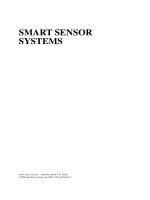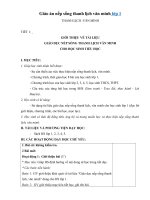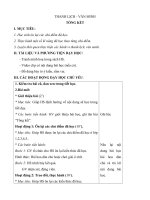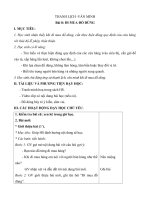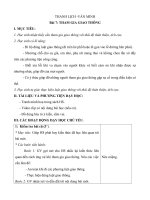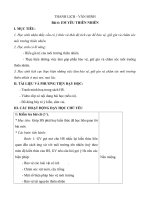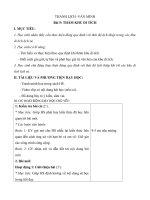HỆ THỐNG CẢM BIẾN ĐIỆN TỬ THÔNG MINH
Bạn đang xem bản rút gọn của tài liệu. Xem và tải ngay bản đầy đủ của tài liệu tại đây (14.48 MB, 411 trang )
P1: OTE/OTE/SPH P2: OTE
fm JWBK268-Meijer August 24, 2008 8:9 Printer Name: Yet to Come
SMART SENSOR
SYSTEMS
Smart Sensor Systems Edited by Gerard C.M. Meijer
© 2008 John Wiley & Sons, Ltd. ISBN: 978-0-470-86691-7
P1: OTE/OTE/SPH P2: OTE
fm JWBK268-Meijer August 24, 2008 8:9 Printer Name: Yet to Come
SMART SENSOR
SYSTEMS
Edited by
Gerard C.M. Meijer
Delft University of Technology, the Netherlands
SensArt, Delft, the Netherlands
A John Wiley and Sons, Ltd, Publicatio
n
P1: OTE/OTE/SPH P2: OTE
fm JWBK268-Meijer August 24, 2008 8:9 Printer Name: Yet to Come
This edition first published 2008
C
2008 John Wiley & Sons, Ltd, except for:
Chapter 4
C
2008 Reinoud Wolffenbuttel. Printed by John Wiley & Sons, Ltd
Chapter 5
C
2008 Michael Vellekoop. Printed by John Wiley & Sons, Ltd
Chapter 6
C
2008 Sander van Herwaarden. Printed by John Wiley & Sons, Ltd
Registered office
John Wiley & Sons, Ltd, The Atrium, Southern Gate, Chichester, West Sussex, PO19 8SQ, United Kingdom
For details of our global editorial offices, for customer services and for information about how to apply for
permission to reuse the copyright material in this book please see our website at www.wiley.com.
The right of the author to be identified as the author of this work has been asserted in accordance with the
Copyright, Designs and Patents Act 1988.
All rights reserved. No part of this publication may be reproduced, stored in a retrieval system, or transmitted, in
any form or by any means, electronic, mechanical, photocopying, recording or otherwise, except as permitted by
the UK Copyright, Designs and Patents Act 1988, without the prior permission of the publisher.
Wiley also publishes its books in a variety of electronic formats. Some content that appears in print may not be
available in electronic books.
Designations used by companies to distinguish their products are often claimed as trademarks. All brand names and
product names used in this book are trade names, service marks, trademarks or registered trademarks of their
respective owners. The publisher is not associated with any product or vendor mentioned in this book. This
publication is designed to provide accurate and authoritative information in regard to the subject matter covered. It
is sold on the understanding that the publisher is not engaged in rendering professional services. If professional
advice or other expert assistance is required, the services of a competent professional should be sought.
Cover picture: copyright Sodern. The sensor on the cover picture was developed by Xensor Integration for Sodern
(subsidiary of EADS)
Library of Congress Cataloging-in-Publication Data
Smart sensor systems/ edited by Gerard C.M. Meijer.
p. cm.
Includes bibliographical references and index.
ISBN 978-0-470-86691-7 (cloth)
1. Detectors–Design and construction. 2. Detectors–Industrial applications. 3. Microcontrollers.
I. Meijer, G. C. M. (Gerard C. M.)
TA165.S55 2008
681
.25–dc22
2008017675
A catalogue record for this book is available from the British Library.
ISBN: 9780470866917
Set in 10/12pt Times by Aptara Inc., New Delhi, India
Printed in Great Britain by Antony Rowe Ltd, Chippenham, Wiltshire
P1: OTE/OTE/SPH P2: OTE
fm JWBK268-Meijer August 11, 2008 10:5 Printer Name: Yet to Come
Contents
Preface xiii
About the Authors xv
1 Smart Sensor Systems: Why? Where? How? 1
Johan H. Huijsing
1.1 Third Industrial Revolution 1
1.2 Definitions for Several Kinds of Sensors 3
1.2.1 Definition of Sensors 3
1.2.2 Definition of Smart Sensors 9
1.2.3 Definition of Integrated Smart Sensors 9
1.2.4 Definition of Integrated Smart Sensor Systems 11
1.3 Automated Production Machines 12
1.4 Automated Consumer Products 16
1.4.1 Smart Cars 16
1.4.2 Smart Homes 16
1.4.3 Smart Domestic Appliances 17
1.4.4 Smart Toys 19
1.5 Conclusion 21
References 21
2 Interface Electronics and Measurement Techniques for Smart
Sensor Systems 23
Gerard C.M. Meijer
2.1 Introduction 23
2.2 Object-oriented Design of Sensor Systems 24
2.3 Sensing Elements and Their Parasitic Effects 25
2.3.1 Compatibility of Packaging 25
2.3.2 Effect of Cable and Wire Impedances 26
2.3.3 Parasitic and Cross-effects in Sensing Elements 27
2.3.4 Excitation Signals for Sensing Elements 29
2.4 Analog-to-digital Conversion 30
2.5 High Accuracy Over a Wide Dynamic Range 33
2.5.1 Systematic, Random and Multi-path Errors 33
2.5.2 Advanced Chopping Techniques 34
2.5.3 Autocalibration 36
P1: OTE/OTE/SPH P2: OTE
fm JWBK268-Meijer August 11, 2008 10:5 Printer Name: Yet to Come
vi Contents
2.5.4 Dynamic Amplification 37
2.5.5 Dynamic Division and Other Dynamic Signal-processing Techniques 40
2.6 A Universal Transducer Interface 41
2.6.1 Description of the Interface Chip and the Applied Measurement Techniques 41
2.6.2 Realization and Experimental Results 47
2.7 Summary and Future Trends 50
2.7.1 Summary 50
2.7.2 Future Trends 51
Problems 51
References 54
3 Silicon Sensors: An Introduction 55
Paddy J. French
3.1 Introduction 55
3.2 Measurement and Control Systems 55
3.3 Transducers 57
3.3.1 Form of Signal-carrying Energy 57
3.3.2 Signal Conversion in Transducers 59
3.3.3 Smart Silicon Sensors 60
3.3.4 Self-generating and Modulating Transducers 63
3.4 Transducer Technologies 63
3.4.1 Introduction 63
3.4.2 Generic Nonsilicon Technologies 64
3.4.3 Silicon 66
3.5 Examples of Silicon Sensors 68
3.5.1 Radiation Domain 68
3.5.2 Mechanical Domain 70
3.5.3 Thermal Domain 70
3.5.4 Magnetic Domain 72
3.5.5 Chemical Domain 74
3.6 Summary and Future Trends 75
3.6.1 Summary 75
3.6.2 Future Trends 75
References 76
4 Optical Sensors Based on Photon Detection 79
Reinoud F. Wolffenbuttel
4.1 Introduction 79
4.2 Photon Absorption in Silicon 81
4.3 The Interface: Photon Transmission Into Silicon 84
4.4 Photon Detection in Silicon Photoconductors 87
4.4.1 Photoconductors in Silicon: Operation and Static Performance 89
4.4.2 Photoconductors in Silicon: Dynamic Performance 93
4.5 Photon Detection in Silicon pn Junctions 93
4.5.1 Defining the Depletion Layer at a pn Junction 94
4.5.2 Electron–hole Collection in the Depletion Layer 97
P1: OTE/OTE/SPH P2: OTE
fm JWBK268-Meijer August 11, 2008 10:5 Printer Name: Yet to Come
Contents vii
4.5.3 Electron–hole Collection in the Substrate 97
4.5.4 Electron–hole Collection Close to the Surface 99
4.5.5 Backside-illuminated Pin Photodiode 100
4.5.6 Electron–hole Collection in Two Stacked pn Junctions 102
4.6 Detection Limit 103
4.6.1 Noise in the Optical Signal 104
4.6.2 Photon Detector Noise 105
4.6.3 Photon Detector Readout 106
4.7 Photon Detectors with Gain 108
4.7.1 The Phototransistor 108
4.7.2 The Avalanche Photodiode 109
4.7.3 Time Integration of Photon-generated Charge 112
4.8 Application Examples 113
4.8.1 Color Sensor in CMOS 113
4.8.2 Optical Microspectrometer in CMOS 115
4.9 Summary and Future Trends 117
4.9.1 Summary 117
4.9.2 Future Trends 118
Problems 119
References 119
5 Physical Chemosensors 121
Michael J. Vellekoop
5.1 Introduction 121
5.1.1 Thin-film Chemical Interfaces 122
5.1.2 Total Analysis Systems 122
5.2 Physical Chemosensing 123
5.3 Energy Domains 124
5.4 Examples and Applications 126
5.5 Examples of in situ Applications 127
5.5.1 Blood Oximeter 127
5.5.2 Thermal Conductivity Detector 127
5.5.3 Engine Oil Monitoring System 129
5.5.4 Oil-condition Sensor Based on Infrared Measurements 130
5.5.5 Electronic Nose 130
5.6 Microfluidics Devices 131
5.6.1 Projection Cytometer 135
5.6.2 Coulter Counter 138
5.6.3 Dielectrophoresis-based Devices 140
5.6.4 High-throughput Screening Arrays 144
5.6.5 Contactless Conductivity Detection in CE 145
5.7 Conclusions 146
Problems 147
References 147
P1: OTE/OTE/SPH P2: OTE
fm JWBK268-Meijer August 11, 2008 10:5 Printer Name: Yet to Come
viii Contents
6 Thermal Sensors 151
Sander (A.W.) van Herwaarden
6.1 The Functional Principle of Thermal Sensors 151
6.1.1 Self-generating Thermal-power Sensors 151
6.1.2 Modulating Thermal-conductance Sensors 152
6.2 Heat Transfer Mechanisms 153
6.3 Thermal Structures 155
6.3.1 Modeling 155
6.3.2 Floating Membranes 160
6.3.3 Cantilever Beams and Bridges 161
6.3.4 Closed Membranes 163
6.4 Temperature-Difference Sensing Elements 165
6.4.1 Introduction 165
6.4.2 Thermocouples 165
6.4.3 Other Elements 168
6.5 Sensors Based on Thermal Measurements 168
6.5.1 Microcalorimeter 169
6.5.2 Psychrometer 170
6.5.3 Infrared Sensor 171
6.5.4 RMS Converter 172
6.5.5 EM Field Sensor 173
6.5.6 Flow Sensor 174
6.5.7 Vacuum Sensor 174
6.5.8 Thermal Conductivity Gauge 176
6.5.9 Acceleration Sensors 177
6.5.10 Nanocalorimeter 177
6.6 Summary and Future Trends 179
6.6.1 Summary 179
6.6.2 Future Trends 179
Problems 180
References 182
7 Smart Temperature Sensors and Temperature-Sensor Systems 185
Gerard C.M. Meijer
7.1 Introduction 185
7.2 Application-related Requirements and Problems of Temperature Sensors 188
7.2.1 Accuracy 189
7.2.2 Short-term and Long-term Stability 189
7.2.3 Noise and Resolution 190
7.2.4 Self-heating 192
7.2.5 Heat Leakage along the Connecting Wires 194
7.2.6 Dynamic Behavior 194
7.3 Resistive Temperature-sensing Elements 196
7.3.1 Practical Mathematical Models 196
7.3.2 Linearity and Linearization 198
P1: OTE/OTE/SPH P2: OTE
fm JWBK268-Meijer August 11, 2008 10:5 Printer Name: Yet to Come
Contents ix
7.4 Temperature-sensor Features of Transistors 200
7.4.1 General Considerations 200
7.4.2 Physical and Mathematical Models 201
7.4.3 PTAT Temperature Sensors 203
7.4.4 Temperature Sensors with an Intrinsic Voltage Reference 207
7.4.5 Calibration and Trimming of Transistor Temperature Sensors 208
7.5 Smart Temperature Sensors and Systems 208
7.5.1 A Smart Temperature Sensor with a Duty-cycle-modulated Output Signal 209
7.5.2 Smart Temperature-sensor Systems with Discrete Elements 212
7.6 Case Studies of Smart-sensor Applications 212
7.6.1 Thermal Detection of Micro-organisms with Smart Sensors 213
7.6.2 Control of Substrate Temperature 217
7.7 Summary and Future Trends 220
7.7.1 Summary 220
7.7.2 Future Trends 221
Problems 222
References 223
8 Capacitive Sensors 225
Xiujun Li and Gerard C.M. Meijer
8.1 Introduction 225
8.2 Basics of Capacitive Sensors 226
8.2.1 Principles 226
8.2.2 Precision of Capacitive Sensors 226
8.3 Examples of Capacitive Sensors 227
8.3.1 Angular Encoders 228
8.3.2 Humidity Sensors 229
8.3.3 Liquid-level Gauges 230
8.4 The Design of Electrode Configurations 231
8.4.1 EMI Effects 231
8.4.2 Electric-field-bending Effects 232
8.4.3 Active-guard Electrodes 232
8.4.4 Floating Electrodes 233
8.4.5 Contamination and Condensation 234
8.5 Reduction of Field-bending Effects: Segmentation 234
8.5.1 Three-layered Electrode Structures 235
8.5.2 A Model for the Electrostatic Field in Electrode Structures 236
8.5.3 Influence of the Electric-field-bending Effects on Linearity 237
8.6 Selectivity for Electrical Signals and Electrical Parameters 237
8.6.1 Selective Detection of Band-limited Frequencies 238
8.6.2 Selective Detection of a Selected Parameter 239
8.6.3 Measurement Techniques to Reduce the Effects of Shunting Conductances 240
8.7 Summary and Future Trends 246
Problems 246
References 247
P1: OTE/OTE/SPH P2: OTE
fm JWBK268-Meijer August 11, 2008 10:5 Printer Name: Yet to Come
x Contents
9 Integrated Hall Magnetic Sensors 249
Radivoje S. Popovi
´
c and Pavel Kejik
9.1 Introduction 249
9.2 Hall Effect and Hall Elements 250
9.2.1 The Hall Effect 250
9.2.2 Hall Elements 253
9.2.3 Characteristics of Hall Elements 253
9.2.4 Integrated Horizontal Hall Plates 256
9.2.5 Integrated Vertical Hall Plates 258
9.3 Integrated Hall Sensor Systems 259
9.3.1 Biasing a Hall Device 260
9.3.2 Reducing Offset and 1/f noise 260
9.3.3 Amplifying the Hall Voltage 262
9.3.4 Integrating Magnetic Functions 265
9.4 Examples of Integrated Hall Magnetic Sensors 267
9.4.1 Magnetic Angular Position Sensor 267
9.4.2 Fully Integrated Three-axis Hall Probe 269
9.4.3 Integrated Hall Probe for Magnetic Microscopy 271
Problems 276
References 276
10 Universal Asynchronous Sensor Interfaces 279
Gerard C.M. Meijer and Xiujun Li
10.1 Introduction 279
10.2 Universal Sensor Interfaces 280
10.3 Asynchronous Converters 283
10.3.1 Conversion of Sensor Signals to the Time Domain 284
10.3.2 Wide-range Conversion of Sensor Signals to the Time Domain
for Very Small or Very Large Signals 287
10.3.3 Output Signals 288
10.3.4 Quantization Noise of Sampled Time-modulated Signals 290
10.3.5 A Comparison between Asynchronous Converters and
Sigma–delta Converters 294
10.4 Dealing with Problems of Low-cost Design of Universal Interface ICs 296
10.5 Front-end Circuits 297
10.5.1 Cross-effects and Interaction 297
10.5.2 Interference 298
10.5.3 Optimization of Components, Circuits and Wiring 298
10.6 Case Studies 299
10.6.1 Front-end Circuits for Capacitive Sensors 299
10.6.2 Front-end Circuits for Resistive Bridges 302
10.6.3 A Front-end Circuit for a Thermocouple-voltage Processor 305
10.7 Summary and Future Trends 307
10.7.1 Summary 307
10.7.2 Future Trends 307
Problems 308
References 311
P1: OTE/OTE/SPH P2: OTE
fm JWBK268-Meijer August 11, 2008 10:5 Printer Name: Yet to Come
Contents xi
11 Data Acquisition for Frequency- and Time-domain Sensors 313
Sergey Y. Yurish
11.1 Introduction 313
11.2 DAQ Boards: State of the Art 314
11.3 DAQ Board Design for Quasi-digital Sensors 316
11.3.1 Advanced Methods for Frequency-to-digital Conversion 316
11.3.2 Examples 322
11.3.3 Methods for Duty-cycle-to-digital Conversion 324
11.3.4 Methods for Phase-shift-to-digital Conversion 326
11.4 Universal Frequency-to-digital Converters (UFDC) 330
11.4.1 ICs for Frequency-to-digital Conversion: State of the Art 332
11.4.2 UFDC: Features and Performances 333
11.5 Applications and Examples 335
11.6 Summary and Future Trends 338
Problems 339
References 340
12 Microcontrollers and Digital Signal Processors for Smart Sensor Systems 343
Ratcho M. Ivanov
12.1 Introduction 343
12.2 MCU and DSP Architectures, Organization, Structures, and Peripherals 344
12.3 Choosing a Low-Power MCU or DSP 347
12.3.1 Average Current Consumption 348
12.3.2 Oscillator and System Clocks 349
12.3.3 Interrupts 350
12.3.4 Peripherals 350
12.3.5 Summary 350
12.4 Timer Modules 351
12.4.1 Introduction to Timer Modules 351
12.4.2 Examples of Timer Module Applications for Various Microcontrollers 355
12.5 Analog Comparators, ADCs, and DACs as Modules of Microcontrollers 370
12.5.1 Introduction 370
12.5.2 Application Examples of Analog Modules 370
12.6 Embedded Networks and LCD Interfacing 373
12.7 Development Tools and Support 374
12.8 Conclusions 374
References Sites 374
Appendix A Material Data 375
Appendix B Conversion for non-SI Units 377
Index 379
Solutions to Problems can be found on the Companion website
P1: OTE/OTE/SPH P2: OTE
fm JWBK268-Meijer August 11, 2008 10:5 Printer Name: Yet to Come
Preface
Thanks to the tremendous efforts of numerous scientists and technologists, sensor technology
has now arrived in its childhood, which means that we expect that it has started a long period
of growth in the intellectual and technological level of sensor systems and that it will reach a
level of maturity. It is difficult to predict where this growth will end and what the final stage
will look like. For the near future, we expect to see the development of autonomous sensors
integrated into distributed systems with intelligent signal processors and smart control of actu-
ators, and powered with a minimum amount of energy. For the longer term, we picture sensor
systems as being components of robots in which the system architecture strongly resembles
that of animals or human beings.
Of course, such ideas are not new. We can even ask ourselves why it is taking so long for
such developments to happen. Is it the difficulty of making a significant step in the level of
technology? Could it be possible that the introduction of nanotechnology, in which we can
organize technical matter all the way down to the atom level, will bring us the new future we
are looking for?
Nobody knows for sure, but it is clear that an important reason for the ‘slow’ progress in
sensor technology can be found in the multidisciplinary character of the required knowledge.
It requires the cooperation of physicists, chemists, electrical and mechanical engineers, and
ICTers. Moreover, these engineers have to cooperate with medical doctors, agriculturists and
horticulturists, and economists.
This book is intended as a reference for designers and users of sensors and sensor systems.
It has been written based on material presented in the multidisciplinary courses ‘Smart Sensor
Systems’ that have been organized at Delft University of Technology since 1995. The scope
of these courses has been to present the basic principles of advanced sensor systems for a
wide, multidisciplinary audience, to develop a common language and scientific background
to discuss t he problems, and to facilitate mutual cooperation. Thus, we hope to contribute
to a continual expansion of the group of people contributing to these world-wide exciting
developments.
During the course of writing this text, many people have assisted us. Many people have
contributed to this book. We highly appreciate the support of the boards of faculties or heads
of our industrial and academic institutes, who have helped us and allowed us to write this
book. We have benefited from the suggestions made by our reviewers: Dr. Ferry N. Toth of
Exalon, Dr. Michiel Pertijs of National Semiconductors, Ir. Jeroen van der Meer of Xensor
Integration, Prof. Albert J.P. Theuwissen of TUDelft, Dr. Andr
´
e Bossche of TUDelft, Ir. Qi
Jia of TUDelft, and all of the authors who also acted as reviewers.
P1: OTE/OTE/SPH P2: OTE
fm JWBK268-Meijer August 11, 2008 10:5 Printer Name: Yet to Come
xiv Preface
At our publisher, John Wiley & Sons, Ltd, we would like to acknowledge the project man-
ager Nicky Skinner for her technical manuscript editing, and executive commissioning editor
Simone Taylor for her encouragements and her help in arranging agreements. We would also
like to thank Mrs. Trudie (G.) Houweling of TUDelft for her secretarial assistance during the
course of this work, and Rob Janse, who made many of the drawings in this book. We wish to
extend our appreciation to Sarah von Galambos for her excellent English and linguistic cor-
rections. Furthermore, we want to express our gratitude to the universities, research institutes
and companies who allowed us to write this text and helped us with illustrative material and
demonstrators to make this book attractive for our readers.
The Companion website for this book is www.wiley.com/go/meijer
smart.
Gerard C.M. Meijer
Delft, the Netherlands
P1: OTE/OTE/SPH P2: OTE
fm JWBK268-Meijer August 11, 2008 10:5 Printer Name: Yet to Come
About the Authors
Gerard C.M. Meijer
Gerard C.M. Meijer was born in Wateringen, the Netherlands, in 1945. He received his M.Sc.
and Ph.D. degrees in Electrical Engineering from Delft University of Technology, Delft, the
Netherlands, in 1972 and 1982, respectively. Since 1972 he has been a member of the re-
search and teaching staff of Delft University of Technology, where he is a professor of analog
electronics and electronic instrumentation. In 1984 and part-time from 1985 to 1987 he was
seconded to Delft Instruments Company, Delft, the Netherlands, where he was involved in the
development of industrial level gauges and temperature transducers. In 1996 he co-founded
the company SensArt, where he is a consultant for the design and development of sensor
systems. In 1999 the Dutch Technology Foundation STW awarded Meijer with the honorary
degree ‘Simon Stevin Meester’. In 2001 he was awarded the Anthony Van Leeuwenhoek
Chair at TUDelft. Meijer is chairman of the National STW Platform on Sensor Technology
and director of the annual Europractice course ‘Smart Sensor Systems’.
Paddy J. French
Paddy J. French received his B.Sc. in mathematics and M.Sc. in electronics from Southampton
University, UK, in 1981 and 1982, respectively. In 1986 he obtained his Ph.D., also from
Southampton University, for his research on the piezoresistive effect in polysilicon. After
18 months as a post-doc at Delft University of Technology, the Netherlands, he moved to
Japan in 1988. For three years he worked on sensors for automotives at Central Engineering
Laboratories of Nissan Motor Company. He returned to Delft University of Technology in
May 1991 were he has been involved in research on micromachining and process optimization
related to sensors. Since 2002 he has chaired the Laboratory for Electronic Instrumentation.
In 1999 he was awarded the Anthony van Leeuwenhoek Chair. He has also received the title
award of ‘Simon Stevin Meester’ from the Dutch Technology Foundation.
Sander (A.W.) van Herwaarden
Sander van Herwaarden was born in 1957, Rotterdam, the Netherlands. In 1982, he received
his B.A. in economics from the Erasmus University in Rotterdam. I n 1983 he received his
M.Sc. and in 1987 his Ph.D. from Delft University of Technology, both in thermal-sensor
subjects. In 1988 he co-founded Xensor Integration and has been managing director since
then. His main activities are in the field of thermal sensors and silicon microstructures.
P1: OTE/OTE/SPH P2: OTE
fm JWBK268-Meijer August 11, 2008 10:5 Printer Name: Yet to Come
xvi About the Authors
Johan H. Huijsing
Johan H. Huijsing was born in Bandung, Indonesia, on May 21, 1938. He received his M.Sc. in
Electrical Engineering from Delft University of Technology, Delft, the Netherlands, in 1969,
and his Ph.D. from the same University in 1981 for his work on operational amplifiers. Since
1969 he has been a member of the Research and Teaching Staff of the Electronic Instrumenta-
tion Laboratory, Department of Electrical Engineering, Delft University of Technology, where
he has been a full professor of electronic instrumentation since 1990, and professor emeritus
since 2003. He teaches courses on electrical measurement techniques, electronic instrumen-
tation, operational amplifiers, and analog-to-digital converters. His field of r esearch is analog
circuit design (operational amplifiers, analog multipliers, etc.) and integrated smart sensors.
He is a fellow of the IEEE. He received the title award of ‘Simon Stevin Meester’ from the
Dutch Technology Foundation.
Ratcho M. Ivanov
Ratcho Ivanov was born in v.Razliv, Bulgaria on December 25, 1945. He received his M.Sc.
and his Ph.D. in Electronics engineering from the Technical University of Sofia, Bulgaria
in 1969 and 1980, respectively. From 1975 to 1977 he specialized on microprocessor-based
systems at the Tokyo Institute of Technology, Japan. Since 1970, he has been employed
at the Technical University of Sofia, where at present he is a professor specialized in the
teaching, design, development and implementation of embedded systems, microcontroller and
microprocessor-based industrial systems, smart sensors systems and applications.
Pavel Kejik
Pavel Kejik was born in the Czech Republic in 1971. He received his university degree in 1994
and Ph.D. degree in 1999 at the Czech Technical University of Prague. In 1999, he joined
the Institute of Microelectronics and Microsystems at the EPFL to work on the Institute’s
circuit design and testing. His research interests include fluxgate magnetometry and micro-
Hall sensors combined with mixed-signal IC design and low-noise circuit design for industrial
applications.
Xiujun Li
Xiujun Li was born in Tianjin, China in 1963. He received his B.Sc. in physics and M.Sc. in
electrical engineering from Nankai University, Tianjin, China in 1983 and 1986, respectively.
In 1997, he received his Ph.D. degree from the faculty of Electrical Engineering, Delft Univer-
sity of Technology, the Netherlands. Since September 1996, he has been employed as a part-
time senior researcher at the Faculty of Electrical Engineering, Mathematics and Computer
Science, Delft University of Technology, where he is involved in research and development of
smart capacitive sensors and low-cost interfaces for smart sensors. Since 1997 he has worked
part-time for Smartec B.V. on smart temperature sensors and smart sensor interfaces. In 2002
he joined Bradford Engineering B.V., Heerle, the Netherlands, where he conducts research
and development of instruments for the space industry.
Radivoje S. Popovi
´
c
Radivoje S. Popovi
´
c received the Dipl. Ing. degree in engineering physics from the Uni-
versity of Belgrade, Yugoslavia in 1969, and the Mag.Sc and Dr.Sc. degrees in electronics
from the University of Nis, Yugoslavia in 1974 and 1978. From 1969 to 1981 he worked for
P1: OTE/OTE/SPH P2: OTE
fm JWBK268-Meijer August 11, 2008 10:5 Printer Name: Yet to Come
About the Authors xvii
Elektronska Industrija, Nis, Yugoslavia; and from 1982 to 1993 for Landis & Gyr AG, Central
R&D, Zug, Switzerland. Since 1994, he has been a professor at the Swiss Federal Institute of
Technology at Lausanne (EPFL), Switzerland. His current research interests include sensors
for magnetic and optical signals, interface electronics, and noise phenomena. Dr Popovic is
author or co-author of about 250 publications and 100 patent applications. He is the founder
of the start-up companies Sentron AG, Sentronis AD, Senis GmbH, and Ametes AG. He is
a member of the Swiss Academy of Engineering Sciences and of the Serbian Academy of
Engineering Sciences.
Michael J. Vellekoop
Michael J. Vellekoop was born in Amsterdam in 1960. He received his B.Sc. degree in physics
in 1982 and his Ph.D. degree in electrical engineering in 1994. In 1988 he co-founded Xen-
sor Integration B.V. where he was managing director until 1996. In that year he initiated a
new group on the topic of physical chemosensors at the DIMES Electronic Instrumentation
Laboratory of the Delft University of Technology, where in 1997 he became an associated
professor. Since 2001 he has been a full professor of industrial sensor systems at the Institute
of Sensor and Actuator Systems at the Vienna University of Technology, Austria. In 2002 he
became head of this Institute. Since 2005 he has been a corresponding member of the Austrian
Academy of Sciences and in the same year he received the Eurosensors Fellow award.
Sergey Y. Yurish
Sergey Y. Yurish was born in Germany in 1963. He received his M.Sc. degree in Automatic
and Telemetry from the State University Lviv Polytechnic, Ukraine, in 1985. Since then, he
has been involved in the development of microcontroller-based and virtual measuring instru-
ments. In 1997 he received his Ph.D. degree in measurements from the same university. In
1996 he joined the Institute of Computer Technologies for different international joint re-
search projects in the smart sensors area, where he worked as Head of the R&D Department.
Since 2006 he has been a professor at the Technical University of Catalonia (UPC-Barcelona).
Professor Yurish is the holder of nine patents and he has also published more than 130 articles,
papers and four books. He is a founder and President of the International Frequency Sensor
Association (IFSA) and Editor-in-Chief of Sensors & Transducers Journal.
Reinoud F. Wolffenbuttel
Reinoud F. Wolffenbuttel received his M.Sc. degree in 1984 and his Ph.D. degree in 1988,
both from the Delft University of Technology. Since 1986 he has been a member of the re-
search and teaching staff of Delft University of Technology, where he is an associate profes-
sor at the Department of Microelectronics. He is involved in research on instrumentation and
measurement in general and on-chip functional integration of microelectronic circuits and sil-
icon sensor, fabrication compatibility issues, and micromachining in silicon and microsystems
in particular. He was a visiting researcher at the University of Michigan, Ann Arbor, USA in
1992, 1999 and 2001, Tohoku University, Sendai, Japan in 1995 and EPFL Lausanne, Switzer-
land in 1997. He is the recipient of a 1997 NWO pioneer award. He was general chairman
of the Dutch National Sensor Conference in 1996, Eurosensors in 1999 and Micromechanics
Europe in 2003.
P1: OTA/XYZ P2: ABC
c01 JWBK268-Meijer August 13, 2008 17:27 Printer Name: Yet to Come
1
Smart Sensor Systems:
Why? Where? How?
Johan H. Huijsing
1.1 Third Industrial Revolution
Automation has three phases:
(1) Mechanization;
(2) Informatization;
(3) Sensorization.
Humans have always tried to extend their capabilities. See Figure 1.1. Firstly, they extended
their mechanical powers. They invented the steam engine, the combustion engine, the elec-
tric motor, and the jet engine. Mechanization thoroughly changed society. The first industrial
revolution was born.
Secondly, they extended their brains, or their ratio. They invented means for artificial logic
and communication: the computer and the internet. This informatization phase is changing
society again, where we cannot yet fully predict the end result.
Mechanization
1900 1950 2000 2050
Informatization Sensorization
Figure 1.1 Sensorization: the third automation revolution
Smart Sensor Systems Edited by Gerard C.M. Meijer
© 2008 John Wiley & Sons, Ltd. ISBN: 978-0-470-86691-7
P1: OTA/XYZ P2: ABC
c01 JWBK268-Meijer August 13, 2008 17:27 Printer Name: Yet to Come
2 Smart Sensor Systems
Figure 1.2 A fully automated airplane showing the triplet of mechanization, informatization and
sensorization
However, this is not all. By inventing sensors, humans are now learning to artificially ex-
pand their senses. Sensorization together with mechanization and informatization will bring
about the third industrial revolution of full automation or robotization.
A good example is the automated flight control system of a modern airplane (Figure 1.2).
It includes many sensors to monitor the flight. The computers process the signals, compare
them with the designed values, and provide control signals for the engines, rudders, and flaps
that move the plane. This triptych of mechanics, computers, and sensors allows the plane to
fly on autopilot.
If aircraft can fly automatically, why then can we still not have our car drive us to work
by simply telling it to do so? Because the sensor system for an autodriver still weighs too
much, is too bulky, and too costly to manufacture. So before we can apply sensorization to
smart cars, smart homes, and industrial production machines, we must reduce the costs, size,
and weight of the sensor system. This effort is the subject of our present challenge to develop
Integrated Smart Sensors, as shown in Table 1.1.
Table 1.1 Integrated smart sensors
Challenge: enabling the measurement of many physical and
(bio)chemical signals
Requirements: low cost, low size, low weight, low power,
self-test, bus or wireless communication
HOW: integrating sensors, actuators and smart interface
electronics, preferably in one IC-package
P1: OTA/XYZ P2: ABC
c01 JWBK268-Meijer August 13, 2008 17:27 Printer Name: Yet to Come
Smart Sensor Systems: Why? Where? How? 3
1.2 Definitions for Several Kinds of Sensors
We will now provide definitions for several kinds of sensors as follows:
r
Sensors
r
Smart Sensors
r
Integrated Smart Sensors
r
Smart Sensors Systems
1.2.1 Definition of Sensors
Sensors transform signals from different energy domains to the electrical domain. Figure 1.3
classifies signals in six domains.
The uppermost domain in Figure 1.3 contains all signals of the radiant or optical domain.
Optical sensors are able to translate these signals into electrical signals, which are depicted
in the lowest domain. An example is an image sensor that translates a picture into an elec-
trical signal. The next domain, to the right is the mechanical signal domain. For example,
an accelerometer or airbag sensor is able to translate mechanical acceleration into an electri-
cal signal. Similarly, a temperature sensor translates the temperature into an electrical signal.
Even electrical sensors exist. They translate electrical signals into other electrical signals, for
instance to measure accurately the voltage difference between two skin electrodes on the chest
of a patient. To the lower left is the magnetic domain. A Hall plate is able to convert a mag-
netic signal into an electrical signal. And finally, from the chemical and biochemical domain
sensors are able to translate these signals into electrical ones. Examples are pH sensors and
DNA sensors.
The physical effects of sensors can be described by differential equations on energy or
power containment [1]. Parameters of cross-effects between different energy domains describe
the cross-sensitivities of a sensor between these signal domains. These effects are shown in
Table 1.2, which places the physical sensor effects in a system. On the left-hand side, we find
the sensor input signal domains. At the top there are the output signal domains. All effects
on the left/upper-right/lower diagonal refer to effects within one signal domain. An example
is photoluminescence within the radiation domain. All effects in the column with electrical
output signals describe sensor effects, for example photoconductivity. All effects in the row
with an electrical signal as input describe actuator effects.
Figure 1.3 Sensor classification according to six signal domains
P1: OTA/XYZ P2: ABC
c01 JWBK268-Meijer August 13, 2008 17:27 Printer Name: Yet to Come
4 Smart Sensor Systems
Table 1.2 Physical sensor effects [1]
In/Out Radiant Mechan. Thermal Electrical Magnetic Chemical
Rad Photo-
luminan.
Radiant
pressure
Radiant
heating
Photo-cond. Photo-magn. Photo-
chem.
Mech. Photo-elastic
effect
Conservation
of moment
Friction heat Piezo-
electricity
magneto-
striction
Pressure-
induced
explos.
Therm. Incan-
descence
Thermal
expansion
Heat
conduction
Seebeck
effect
Curie-Weiss
law
Endotherm
raction
Electr. Inject.
Luminan.
Piezo-electr. Peltier effect PNjunction
effect
Ampere’s
law
Electrolysis
Magn. Faraday
effect
Magneto-
striction
Ettinghausing
effect
Hall effect Magnetic
induction
Chem. Chemo-
lumin.
Explosion
reaction
Exothermal
reaction
Volta effect Chem.
reaction
Sensors can be further divided into passive (self-generating) and active (modulating) types.
This is depicted in Figure 1.4. Passive sensors such as the electrodynamic microphone ob-
tain their output energy from the input signal; active sensors on the other hand, such as the
condenser microphone, obtain it from an internal power source. Active sensors can achieve a
large power gain between the input and output signals. The sensor cube in Figure 1.5 shows a
three-dimensional space of input, output, and power-source signals for sensors. A further clas-
sification of sensors is shown in Figure 1.6. Two classes can be distinguished: open systems,
in which there is no feedback, and closed-loop systems, with feedback. A spring balance is a
good mechanical example of the first; a chemical balance is a good example of the second.
subject of
measurement
subject of
measurement
input signal
input signal
sensor
sensor
output power
output signal
output power
output signal
losses
losses
(a) self-generating sensor
(b) modulating sensor
power of the
phenomenon
power of the
phenomenon
power of
input signal
power of
input signal
power
source
Figure 1.4 Self-generation and modulating sensors [2]
P1: OTA/XYZ P2: ABC
c01 JWBK268-Meijer August 13, 2008 17:27 Printer Name: Yet to Come
Smart Sensor Systems: Why? Where? How? 5
Figure 1.5 Sensor cube [1]
To measure with a chemical balance, weights have to be placed on the balance scale in
order to bring the pointer to zero. The advantage of this system is that the actual sensor only
needs to sense accurately around the zero point. The feedback placing of weights determines
the value. In an open sensor system, the sensor has to provide the linearity and accuracy of
the signal transfer all by itself.
Figures 1.7 and 1.8 depict the multitude of materials that can be chosen for sensors. Semi-
conductors are becoming increasingly popular as a sensor material because of their stable
spring balance
input
input
converter
(spring)
comparator
deviation
(inclination of
the rod
0)
(a) open system (no feedback)
(b) closed system (with feedback)
chemical balance
* adjustment weights are added or removed to make the deviation zero
displacement
output
output
mass
(extension
of spring)
adjustments
weights*
mass
mass
Figure 1.6 Open and closed loop sensor systems [2]
P1: OTA/XYZ P2: ABC
c01 JWBK268-Meijer August 13, 2008 17:27 Printer Name: Yet to Come
6 Smart Sensor Systems
analog
frequency
analog
duty cycle digital
foil
pressure
humidity
level
microwave
motion
level
velocity
ceramic
temperature
gases
opto-
electronic
radiation
position
screen
printing
(thick film)
temperature
motion
volume
flow rate
level
pressure
sound
acidity
gas
humidity
temperature
radiation
luminance
color
density
mass
time
torque
force
rotational speed
acceleration
velocity
vibration
position
angle
length
thin film
temperature
pressure
semi-
conductor
(primarily
silicon)
pressure
temperature
flow rate
position
Figure 1.7 Sensor materials [3]
Figure 1.8 Which one? [2]
P1: OTA/XYZ P2: ABC
c01 JWBK268-Meijer August 13, 2008 17:27 Printer Name: Yet to Come
Smart Sensor Systems: Why? Where? How? 7
crystalline structure and because its standardization in mass fabrication is being improved;
and because of their low price.
The production economics of sensors is often hampered by the multitude of sensor
parameters to be measured. This is illustrated in Table 1.3.
Even for one parameter, such as pressure, there are many specifications: accuracy, sensitiv-
ity, noise, resolution, dynamic range, and environmental requirements. For this reason there
are thousands of different pressure sensors on the market (see Figure 1.9).
Another complicating factor is the many output signal types of sensors. Some are listed in
Table 1.4.
Further standardization and compacting is needed. The smart sensor is the solution (see
Figure 1.10).
Table 1.3 Sensor parameters [3]
1. mechanical
parameters of solids
• acceleration
• angle
• area
• diameter
• distance
• elasticity
• expansion
• filling level
• force
• form
• gradient
• hardness
• height
• length
• mass
• mass flow rate
• moment
• movement
• orientation
• pitch
• position
• pressure
• proximity
• revolutions per
minute
• rotating velocity
• roughness
• tension
• torque
• torsion
• velocity
• vibration
• way
• weight
2. mechanical
parameters of fluids
and gases
• density
• flow direction
• flow velocity
• level
• pressure
• rate of flow
• vacuum
• viscosity
• volume
3. thermal parameters
• enthalpy
• entropy
• temperature
• thermal capacity
• thermal conduction
• thermal expansion
• thermal radiation
• thermal radiation
temperature
4. optical parameters
• color
• image
• light polarization
• light wave-length
• luminance
• luminous intensity
• reflection
• refractive index
5. acoustic parameters
• sound frequency
• sound intensity
• sound polarization
• sound pressure
• sound velocity
• time of travel
6. nuclear radiation
• ionization degree
• mass absorption
• radiation dose
• radiation energy
• radiation flux
• radiation type
7. magnetic &
electrical parameters
• capacity
• charge
• current
• dielectric constant
• electric field
• electric power
• electric resistance
• frequency
• inductivity
• magnetic field
• phase
8. chemical parameters
• cloudiness
• composition
• concentration
• dust concentration
• electrical
conductivity
• humidity
• ice
• impurities
• ionization degree
• molar weight
• particle form
• particle size
• percentage of
foreign matter
• pH-value
• polymerization
degree
• reaction rate
• rendox potential
• thermal conductivity
• water content
9. other significant
parameters
• frequency
• pulse duration
• quantity
• time
P1: OTA/XYZ P2: ABC
c01 JWBK268-Meijer August 13, 2008 17:27 Printer Name: Yet to Come
Figure 1.9 Sensitivity? Accuracy? [2]
Table 1.4 Non-standard sensor signals
Voltage: Thermo Couple, Bandgap Voltage
Current: Bip. trans., P.S.D., Radiation Detector
Resistance: Strain-Gauge Bridge, Hall Sensor
Capacitance: Humidity, Tactile, Accelerometer
Inductance: (difficult on-chip)
Figure 1.10 Smart sensor? [2]
P1: OTA/XYZ P2: ABC
c01 JWBK268-Meijer August 13, 2008 17:27 Printer Name: Yet to Come
Smart Sensor Systems: Why? Where? How? 9
bus
digital
I II III
analog
sensor
encapsulation
bus
digital
analog
sensor
bus
digital
analog
sensor
Figure 1.11 Hybrid smart sensors
1.2.2 Definition of Smart Sensors
If we combine a sensor, an analog interface circuit, an analog to digital converter (ADC) and
a bus interface in one housing, we get a smart sensor. Three hybrid smart sensors are shown
in Figure 1.11, which differ in the degree to which they are already integrated on the sensor
chip. This calls for standardization. And hence the sensor must become smarter.
In the first hybrid smart sensor, a universal sensor interface (USI) can be used to connect
the sensor with the digital bus. In the second one, the sensor and signal conditioner have
been integrated. However, the ADC and bus interface are still outside. In the third hybrid, the
sensor is already combined with an interface circuit on one chip that provides a duty cycle or
bit stream. Just the bus interface is still needed separately.
At this level, still many output formats exist, as shown in Table 1.5.
1.2.3 Definition of Integrated Smart Sensors
If we integrate all functions from sensor to bus interface in one chip, we get an integrated
smart sensor, as depicted in Figure 1.12.
Table 1.5 Standard sensor interface signals
Sign. Cond.: Analog Voltage 0.5 V to 4.5 V
AnalogCurrent 4mAto20mA
Sign. Conversion: Frequency 2 kHz to 22 kHz
Duty Cycle 10 % to 90 %
Bit Stream
Bites
Bus Output: IS
2
,I
2
C
D
2
B, Field, CAN
P1: OTA/XYZ P2: ABC
c01 JWBK268-Meijer August 13, 2008 17:27 Printer Name: Yet to Come
10 Smart Sensor Systems
optical
mecha-
nical
chemi-
cal
thermal
mag-
netic
Figure 1.12 Integrated smart sensor
An integrated smart sensor should contain all elements necessary per node: one or more
sensors, amplifiers, a chopper and multiplexers, an AD converter, buffers, a bus interface,
addresses, and control and power management. This is shown in Figure 1.13.
Although fully integrating all functions will be expensive, mass-production of the resulting
sensor can keep the cost per integrated smart sensor reasonable. Another upside is that the
supply
ground
clock
data
addr. interface contr.
digital
analog
one chip
sensor 2
sensor 1
amplifier
chopper/multiplexer
A/D converter
counter
Figure 1.13 Functions of an integrated smart sensor
